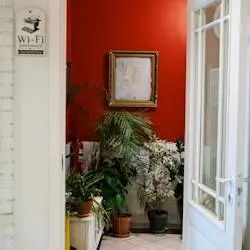
Level 1:
Most doors open inward. They don’t open outward. Why is that? There are few reasons. Safety is a big reason. Inward doors keep us safe during fires. They also stop us from hitting people who walk by our door. Another reason is weather. Wind can’t push inward doors open. Also, outward doors need more space. This can be a problem in small rooms or busy places. So, doors open inward because of safety, weather, and space.
Level 2:
Have you ever noticed that most doors you encounter open inward, rather than outward? You might think it’s a random choice, but there’s method behind the way doors work. Several factors, including safety, weather-proofing, and space considerations, contribute to why doors are designed to open inward.
In case of emergencies like fires, inward opening doors serve as a safety measure. It’s easier to forcefully open a door pulling it towards you rather than pushing it outward. Furthermore, doors opening toward the inside prevent you from accidentally hitting passers-by when you swing the door open. Inward opening doors also offer better protection against weather, especially wind, which run the risk of blowing an outward door open. Finally, in terms of space, doors that open outward take up more room when opened, which can pose problems in tight spaces or busy areas.
In short, the way doors swing is a well-thought-out feature.
Full Story:
The unsung heroes of our homes and buildings – doors! An everyday marvel that we often take for granted, they gracefully swing open and shut, neatly dividing the inner and outer world and offering security and privacy. But have you ever paused to contemplate why most doors generally open inward, rather than outward? What could possibly be the reason behind such an apparently arbitrary choice?
Rest assured, architects and designers didn’t just coin this design whimsically one fine day. These industry professionals, who are certainly worth their salt, have reasons that come part and parcel with such design decisions.
At the heart of the matter lies safety. Whether it’s an office door or your living room door, having the doors open towards the inside can play a crucial role during emergencies, notably fires. If rescuers need to break down a door in a crisis, it’s much easier to forcefully open a door by pulling it towards oneself than pushing against it. An outward door might also obstruct the escape path in a tight hallway or stairwell, a situation you’d be fit to be tied about in a fire.
Another practical consideration is the unsuspecting pedestrian or passer-by. Imagine opening your front door and accidentally smacking an unsuspecting passer-by because it swung outwards. That’s an accident waiting to happen and an apology we’d all like to avoid.
The design also takes into account the fight against nature. For places with strong winds, an inward opening door offers better resistance. The wind can’t easily force it open, offering more weather-proofing benefits than an outward-opening door.
Finally, with space considerations, doors that swing outward usually need more floor area, a factor that might not always be available. In smaller rooms or crowded spaces, this would pose a real issue, creating awkward navigation or blocking areas unnecessarily.
To the untrained eye, door directions might seem like a small, insignificant detail. However, architects don’t have the luxury to be complacent about even the smallest of features. They must carefully take into account the implications of every design aspect, especially those that seem the most trivial.
Whether it’s trivial characteristics like door swing, or more glaring ones like window placement, everything is a part of the larger architectural equation that blends function and design. The orientation of a door might seem simple but it takes into account so many factors: safety, weather, traffic flow, and space usage. This level of detail, forged in the fires of careful planning and design, is what sets apart a good building from a great one.
While we may now look at the humble door with a newfound appreciation, let’s not forget the architects who brought them into being with such attention to detail. Their meticulous work allows us to enjoy comfortable, functional, and safe living and working spaces.
Questions:
Question: Why do doors generally open inward?
Answer: Doors open inward for various reasons, primarily for safety measures in case of emergencies like fires. They also prevent accidentally hitting passers-by, offer better resistance against wind, and conserve space in smaller rooms or crowded areas.
Question: How do inward opening doors contribute to safety during emergencies?
Answer: In emergencies like fires, inward opening doors are easier to forcefully open by pulling towards oneself, and they do not obstruct escape paths in tight hallways or stairwells.
Question: Why do inward opening doors offer better protection against weather?
Answer: Inward opening doors offer better protection against weather, especially wind, because the wind can’t easily force the door open.
Question: What are the advantages of inward opening doors in terms of space considerations?
Answer: Doors that open inward conserve more floor area, which can be beneficial in smaller rooms or crowded spaces as they do not block areas or create awkward navigation when opened.
Question: Do you think the direction a door opens is an important detail in architectural design?
Answer: Opinion-based answer: Yes, the direction a door opens is an important detail in architecture. It impacts safety, flow of foot traffic, weather resistance and efficient use of space. Therefore, careful consideration must go into deciding the direction doors should open in any given design.
Fill in the Blanks:
coin, worth their salt, come part and parcel, fit to be tied, take into account, implications, complacent, forged, brought them into being
Architects and designers didn’t just ______ this design whimsically one fine day.
These industry professionals, who are certainly ________, have reasons that ________ with such design decisions.
At the heart of the matter lies safety. An outward door might also obstruct the escape path in a tight hallway or stairwell, a situation you’d be ______ about in a fire.
The design also takes into ______ the fight against nature.
architects don’t have the luxury to be _______ about even the smallest of features.
They must carefully _______ the _______ of every design aspect, especially those that seem the most trivial.
This level of detail, _____ in the fires of careful planning and design, is what sets apart a good building from a great one.
The architects who ______ them into being with such attention to detail.
Vocabulary:
Coin - (verb) to devise or create (a new word or phrase).
Worth their salt - (phrase) deserving of respect or admiration; competent or capable at doing their job.
Come part and parcel - (phrase) to be a feature or characteristic that is integral or inseparable from something.
Fit to be tied - (phrase) extremely angry or upset.
Take into account - (phrase) to consider or keep in mind in making a decision or forming a judgement.
Implications - (noun) the possible consequences or effects of an action, decision, or event.
Complacent - (adjective) showing satisfaction or contentment, often without being aware of potential dangers or problems.
Forge - (verb) to shape or create (something) through intense effort or adversity.
Brought into being - (phrase) created or caused to exist.




